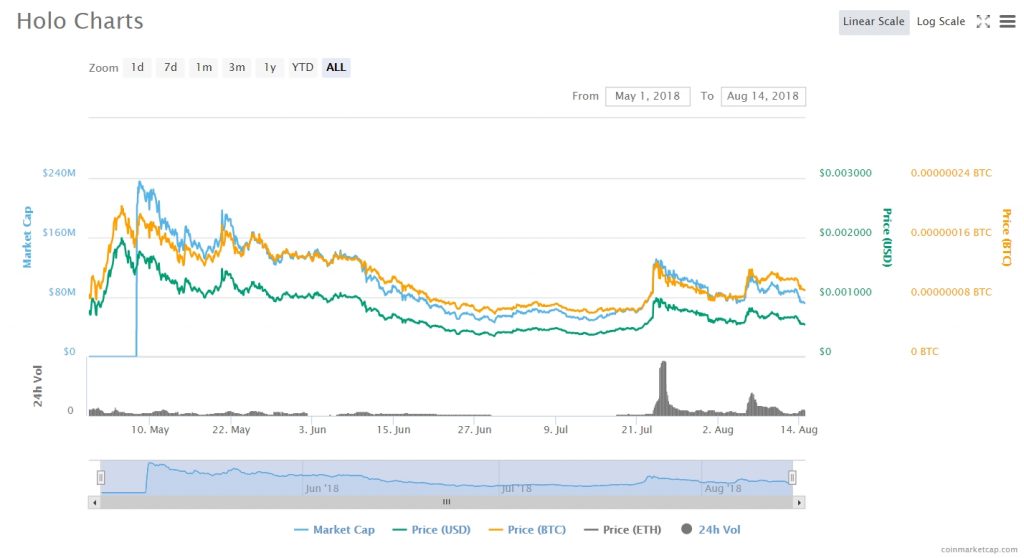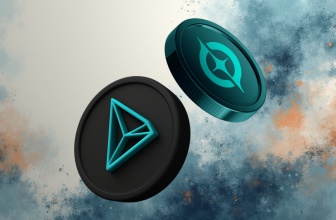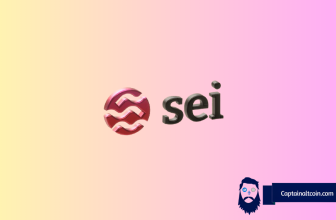
Holochain has been pretty stagnant throughout the month of July before we saw it break out quite strongly on July 23rd. The price went from 0.000380 USD/6 satoshi to 0.000977 USD/13 satoshi in under a week, effectively more than doubling the token’s value in that short time frame. Since that breakout HOT consolidated for a while before another spike, this time on August 6th, saw it go up to 0.000810 USD/12 satoshi. It has been a bumpy ride since which has culminated with the general market blowout.

Currently one HOT is worth $0.000567 USD (a drop of 5.15% in the last 24 hours)/0.00000009 BTC (a drop of 4.16% in the last 24 hours). Daily trade volume is nothing to write home about, sitting at 990 BTC. With a market cap of 68,176,882 USD Holochain is currently the 76th most valuable project on the market.
?Read our article about Gatehub – crypto exchange and wallet.
Holochain represents an alternative for blockchain technology that provides its users with distributed (NOT decentralized) computing and applications using HoloPorts. HoloPorts allow the network to scale due to the network load being offloaded across all of the nodes linked to the network. Holoports are basically the network nodes of this project that are optimized for hosting the network and need to be purchased directly from the project; while they currently come as preset hardware, the Holo team did promise that in the future people will be able to install Holo software on their own hardware. To understand the nodes a bit better I’ll quote Arthur Brook, the co-founder of the project:
The project is an AirBNB-type marketplace which lets people rent computing power for hosting distributed applications. It runs on Holochain network, which is the framework for building apps compatible with Holo. As mentioned, the network structure is slightly different than what you usually see in blockchains and Jean Russel, ICO project lead, explains this further:
The structure is different, so it’s not about having a distributed ledger that everybody is connecting to; it’s about having individual source chains that are validated against each other and checked against their neighbors, so there’s a sufficiency rather than everybody having to get on.
If you want to use the Holochain network and its applications you must contribute computing resources to the network. The network doesn’t depend on centralized servers and instead functions on the peer to peer (P2P) principle; this means that the data is sharded throughout the network, and if a single node goes offline the data can be accessed from other nodes, a technology that functions similarly to torrenting.
“Every node has its own chain, its own source chain, and all of the changes that it contributes to the system are signed to its chain and then shared to sort of distributed GitHub, if you will. But it’s a DHT, which is the technology that BitTorrent uses.”
The network is therefore not dependent on trusted third parties nor does it have centralized points of failure. Holo will employ Zilliqa-like sharding which will lighten the load it has to bear with each new added node. Some compare HoloChain to Hashgraph, but the distinct difference here is that HoloChain is open source while Hashgraph isn’t.
HoloTokens are ERC20 ICO tokens that will be redeemable for Holo fuel (a mutual credit currency, not a token) within the project’s ecosystem. The redeeming will begin once the Holo mainnet launches (community expects this to happen in Q4 of 2018). Holo fuel is backed by the networks distributed computing and hosting services. Application creators will need Holo fuel to pay for hosting services. To earn Holo fuel you can do something called “Proof-Of-Service” by providing processing power, bandwidth and storage space. You will be able to exchange your Holo Fuel for other cryptocurrencies and national currencies.
This project seems to be more suited for social media-like projects which don’t need to function on top of a full blockchain (in fact, there is already a Twitter clone called Clutter being developed for the Holochain platform). Some mention Tinder, Steam, Playstore/Applestore clones, charity focused applications, crisis prevention and first responder apps. There’s even a thread on Reddit which jokingly suggests that Binance might be developing its own hApp.
The technology is interesting, if not that new, since it was previously used in torrenting and now co-opted to create a network for distributed computing. Holochain is open source and has a decent support of its community, and doesn’t look like a scam from where we stand. What could bring them down eventually is the fact that they are gunning for a very saturated market niche, where competitors like Ethereum, Zilliqa, Tron, EOS and many others are attempting to do relatively the same thing as Holo. They do however promise a lot, including low electricity usage by their nodes, decentralized cloud hosting that will rival AWS/Azure/Google Cloud and scalability “million times greater than Ethereum”. Once their mainnet goes live, we will see how much truth there is to their promises. If they deliver at least half of what they promise, the token price could easily go 10x from the current one.








